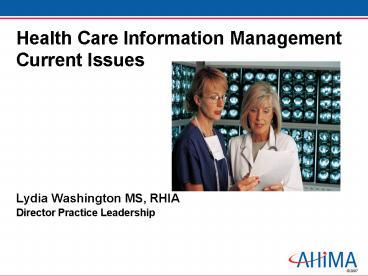Health Care Information Management Current Issues PowerPoint PPT Presentation
1 / 15
Title: Health Care Information Management Current Issues
1
Health Care Information Management Current Issues
- Lydia Washington MS, RHIA
- Director Practice Leadership
2
Health Care Industry Trends and Drivers for
Information Management
- Transparency of cost and quality data
- Patient care safety and quality
- P4P
- Consumer-driven health care
- Personalized health care
- Greater out of pocket costs
3
Public and Private Health IT initiatives
- ONC
- AHIC
- CCHIT
- HL-7
- HITSP
- HISPC
- Standards development
- Health Information Exchange
- Product Certification
4
Health Care IM Challenges
- Slow adoption of electronic health records
- Inattention to business and legal needs in the
EHR - E-Discovery
- Recognition of the need for information lifecycle
management
5
Current State Hybrid Health Records
- Paper and electronic
- Multimedia
- Multiple sources and business process/data owners
- EHR is a system of systems
- Cost, workflow and productivity as major barriers
6
Business and legal needs of the EHR
- A focus on the clinical functions
- Design issues
- Multiple renderings and versions
- Lax authentication
- Documentation
- Impact on compliance, regulatory, accreditation
and litigation needs
7
What is the EHR? (Working Definition for CCHIT)
- An EHR is the longitudinal, secure electronic
health information pertaining to an individual,
or generated real time as health care is rendered
to that individual. - The EHR (1) improves patient safety and
efficiency of care by providing clinicians with
timely, authorized access to information,
evidence-based clinical decision support, and
streamlined work flows and communications, (2)
increases operational efficiency by supporting
administrative, financial, and reporting
processes, and (3) improves population health by
supporting research and public health disease
surveillance. - Note Electronic in the first sentence of the
first paragraph implies that both non-computable
(e.g., scanned images) and process-able data are
parts of an EHR.
8
EHR Information Resources
- Structured electronic data
- Scanned documents
- Voice data (dictation)
- Medical images (x-rays, scans, etc.)
- Tracings
- Video
- Etc. . . .
9
Non-care Uses of Health Records and Information
- Reimbursement
- Accreditation, regulatory compliance
- Quality management and performance measurement
- Public and population health
- Clinical research
- Litigation
10
E-Discovery
- Litigious nature of health care
- Implications for EHR
- Role of metadata
- How to preserve
- Greater emphasis on retention and destruction
- Need for enterprise strategy
- Policies
- Training
- Technology
11
Need for information lifecycle management
- Volume and storage issues
- Technology obsolescence
- Multiple renderings and versions
- Metadata and clinical decision support
12
Operational and Archive Record Life Cycle
Strategies
Transfer legal EHR data for long term archive
13
IM in EHRM
- Create and administer a plan that manages all
content that comprises the health record
including - an index or other tool that describes, locates
and tracks the information resources that
comprise the health record - Identify informational content/resources that are
not considered to be part of the health record - Develop, coordinate and administer processes for
disclosures of health information - Develop and administer a records retention and
disposition schedule that complies with
applicable regulatory and business needs
14
Collaboration is not optional
- Educate and collaborate with IT to integrate ERM
into information and technology planning - Work with clinicians, data owners and Compliance
to incorporate ERM in policies and required
training - Audit and report compliance with ERM policies
- Participate in litigation response planning
15
Questions/DiscussionLydia.Washington_at_AHIMA.
org

